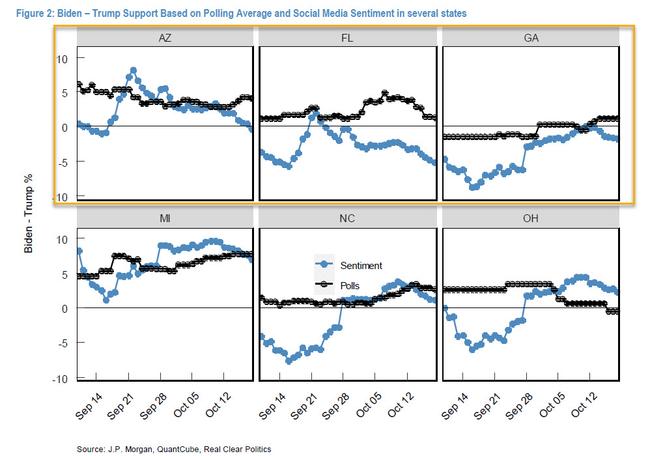JPMorgan's Kolanovic Has Another Warning For Those Expecting A Crushing Biden Victory Tyler Durden Wed, 10/21/2020 - 13:04
Last week, we published an article detailing a warning from JPMorgan's top quant Marko Kolanvoci to all those expecting a landslide Biden win (and by extension Blue Sweep) in which he showed the recent changes in voter registration data and their possible implication for state outcomes. In a nutshell, the JPM strategist found that there had been a sizable increase in Republican voter registrations in key battleground states compared to only modest increases in Democrat registrations...
... and also observed that the change in D-R (Democrats less Republicans) registrations "highly correlates with the subsequent change in D-R voting outcomes."
We summarized that if Kolanovic's hypothesis is accurate, the change in voter registration data shown above would immediately invalidate all polls such as that most popular one from Real Clear Politics showing Biden sweeping across the Battleground states. In fact, we concluded that while he does not say it, "the implication from the Kolanovic analysis is that Trump may well end up winning the critical trio of Pennsylvania (20 Electoral votes), Florida (29 votes) and North Carolina (15 votes)." That said, Kolanovic hedged by saying that changes in voter registration was only one variable in determining the election outcome, and "these results should not be taken as a prediction of state election outcomes."
Fast forward to today when the JPM quant lays out another variable which also suggests that Trump's odds of victory are far higher than conventional (and flawed as the 2016 election showed) polling would imply.
In a report published this morning, Kolanovic presents a Twitter sentiment analysis on the US election and compares it with the traditional polling data. The top level data is presented in the chart below: it shows the Biden – Trump support at the national level based on QuantCube Social Media (Twitter) Analytics, and compares it to polling averages from RealClearPolitics.
Commenting on the data, Kolanovic says that when looking at the evolution of social media sentiment, one sees that "Biden’s lead over Trump widened in September (possibly as a result of the first debate, market weakness, and COVID developments). The sentiment bottomed with the president’s COVID diagnosis but started meaningfully recovering since then." The quant also notes that "social media sentiment appears to be a leading indicator of the polling average. Therefore, all else equal, one could expect the polls to tighten in the near future."
Here, another key consideration is that even the sentiment data is likely biased in Biden's favor as the recent scandal involving Twitter and Facebook's suppression of Hunter Biden news demonstrated. As even JPMorgan admits, "one should also be mindful that social media signals may not be unbiased – suppressing or boosting certain types of accounts and messages would skew the signals. For instance, on a number of occasions, messages from the president himself and stories possibly favorable for him (e.g. NY Post, etc.) were suppressed." For these reasons, he writes "while we believe directionally social media sentiment is a good signal, we would advise against taking at face value the absolute reading (i.e. there could be a persistent bias) as well as the magnitude of the sentiment shifts (i.e. there could be systematic de-boosting and throttling of accounts and messages)."
Last, but certainly not least and perhaps the most important observation from Kolanovic, comes from his discussion of the polls vs sentiment divergence not at the aggregate level but within battleground states.
As indicated in the next chart, which shows the Biden – Trump support delta in several states based on QuantCube Social Media Analytics and RealClearPolitics Polling Averages, the JPM quant observes that, "in several states, there is a divergence between social media sentiment analysis and polls. For instance in Arizona, Florida, and Georgia, sentiment diverges from the polls."
The table below summarizes the above data, underscoring the dramatic shift in pro-Trump sentiment vs polls in 3 of the battleground states.
The implications are profound: if, as Kolanovic suggests, social media sentiment (as biased against Trump as it may be) is a leading indicator to polling, then Trump's is already ahead of Biden in such key battleground states as Arizona, Florida, and Georgia (with the polls expected to catch up in the coming days), which combine for a total of 56 electoral votes, and could well end up being the swing factor deciding the outcome of the election.
http://dlvr.it/Rk3lT3

No comments:
Post a Comment